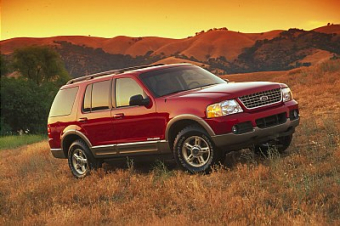
This Week:
- Custom
Chrysler PT Cruiser Embodies Hot Rod Era in Modern Version of Classic
Panel Truck
. - Triulzi
Appointed GM Accessories General Director
. - ‘The
Kobe’: adidas – Audi – Design story
. - Bridgestone/Firestone
Continues Efforts to Identify Root Cause
.
.
© 1998
- 2000 Copyright &
Disclaimer
Automotive Intelligence,
www.autointell.com
All Rights Reserved .
For questions please contact
editor@autointell.com

News of November 07, 2000
|
Ford
Previews 2002-Model Explorer At New England International Auto Show |
|
Ford Explorer Photo: Ford |
|
BOSTON
- The newest generation of the world's best-selling sport utility
vehicle (SUV), the Ford Explorer, was introduced here today at the New
England International Auto Show. The all-new 2002-model Ford Explorer
was unveiled to news media by Doug Scott, SUV Group Marketing Manager
for the Ford Division of Ford Motor Company. The
2002-model Explorer will debut in the first quarter of calendar 2001
with improved package, ride, comfort, safety and design. A new
independent rear suspension system and unique frame design allow for a
lower step-in height and a third row of seats. Inside,
Explorer's passengers have more room to spread out. The passenger
compartment is two inches
wider than the current model and, for the first time, has an optional
third row of seating. These benefits were made possible by Explorer's
2.5-inch wider track and efficient packaging of the new independent rear
suspension. The second- and third-row seats also fold down to create a
flat-surfaced cargo area. Explorer
offers one of the most comprehensive safety and security packages
available. This includes Ford's new industry-leading Safety Canopy,
which includes side-curtain air bags (available at launch) and rollover
protection (available later in 2001). The side-curtain air bags deploy
from the headliner across approximately 75 percent of the side glass
area to help protect first- and second-row occupants in the outboard
seating positions during a side impact. Electronic
rollover sensors will be available later in 2001. They measure whether
the vehicle is tilting, how fast the lean angle is changing and whether
the combination means the vehicle might roll over. The system can deploy
the side-curtain air bags to help prevent passengers from being ejected
from the side of the vehicle. The air bags remain inflated for up to 6
seconds -- far longer than conventional air bags -- to provide
additional protection. Explorer
also will be Ford's first SUV with AdvanceTrac™ interactive vehicle
dynamics (available later in 2001). This computer-driven system uses a
series of sensors to measure whether the vehicle has begun to slide,
then applies braking to whichever wheel will bring it back under
control. Ford's
Personal Safety System also will be available later in 2001. The
Personal Safety System uses dual-stage driver and front passenger air
bags that deploy differently based on several factors, including the
severity of the crash, front seat occupant safety belt usage and the
driver's seat position. At
the same time, the design team made Explorer more friendly to other
vehicles on the road by lowering its bumper beam height 65 millimeters
-- more than 2 inches -- to be on par with most passenger cars. For
better driver comfort -- particularly for very tall or short drivers --
power adjustable accelerator and brake pedals are available, while the
Reverse Sensing System is available as a parking aid. A
sophisticated new all-aluminum 4.6-liter overhead cam V-8 engine brings
240 horsepower, an increase of 25 horsepower over the previous V-8. It
is designed to go 100,000 miles before its first scheduled tune-up under
normal driving conditions with routine fluid and filter changes.
Explorer's standard engine is an improved 4.0-liter single overhead cam
V-6, which generates 210 horsepower and 250 foot-pounds of peak torque.
Both
engines meet Low Emissions Vehicle (LEV) standards. Fuel economy has
been held constant, even though the Explorer is larger and can seat two
more passengers than the current model. Weight savers include
all-aluminum hood, the aluminum V-8 engine block and a magnesium cross
beam. To
help reduce its impact on the environment, Explorer is an estimated
90-percent recyclable by weight.
More than 10 percent of its plastic parts contain post-consumer recycled
material. Explorer production will use an estimated 6.3 million pounds
of recycled non-metallic parts inside the vehicles every year. The
new Explorer will be available in Eddie Bauer, Limited, XLT and XLS trim
levels. (November
3, 2000) |
[Homepage] [
News] [ Companies] [
Management] [ Publications]
[ Events] [ Careers]
[Services] [Discussion] [
Guestbook]
[ Search]
